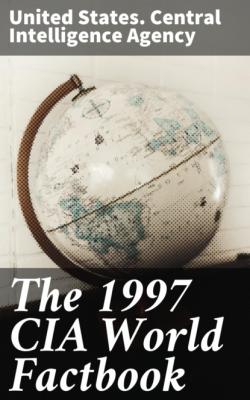The 1997 CIA World Factbook. United States. Central Intelligence Agency
Чтение книги онлайн.
Читать онлайн книгу The 1997 CIA World Factbook - United States. Central Intelligence Agency страница 32
 MANUKIAN]; Union of National Self-Determination or NSDU [Paruir
MANUKIAN]; Union of National Self-Determination or NSDU [ParuirHAIRIKIAN, chairman]; Democratic Liberal Party or DLP [Rouben
MIRZAKHANIAN, chairman]; Armenian Revolutionary Federation or ARF
[Rouben HAKOBIAN, chairman]
International organization participation: BSEC, CCC, CE (guest), CIS,
EBRD, ECE, ESCAP, FAO, IAEA, IBRD, ICAO, IDA, IFAD, IFC, IFRCS, ILO,
IMF, Intelsat, Interpol, IOC, IOM, ISO (correspondent), ITU, NACC, NAM
(observer), OSCE, PFP, UN, UNCTAD, UNESCO, UNIDO, UPU, WFTU, WHO,
WIPO, WMO, WTrO (applicant)
Diplomatic representation in the US: chief of mission: Ambassador Ruben SHUGARIAN chancery: 2225 R Street NW, Washington, DC 20008 telephone: [1] (202) 319–1976 FAX : [1] (202) 319–2982 consulate(s) general: Los Angeles
Diplomatic representation from the US: chief of mission: Ambassador Peter TOMSEN embassy: 18 Gen Bagramian, Yerevan mailing address : use embassy street address telephone: [374] (2) 151–144, 524–661 FAX: [374] (2) 151–550
Flag description: three equal horizontal bands of red (top), blue, and gold
Economy
Economy - overview: Under the old Soviet central planning system, Armenia had developed a modern industrial sector, supplying machine building tools, textiles, and other manufactured goods to sister republics in exchange for raw materials and energy. Since the implosion of the USSR in December 1991, Armenia has switched to small-scale agriculture away from the large agroindustrial complexes of the Soviet area. The privatization of industry has been at a much slower pace. Armenia is a food importer and its mineral deposits (gold, bauxite) are small. The ongoing conflict with Azerbaijan over the ethnic Armenian-dominated region of Nagorno-Karabakh and the embargoes imposed by Azerbaijan and Turkey contributed to a severe economic decline in the early 1990s. By 1994, however, the Armenian Government had launched an ambitious IMF-sponsored economic program that has resulted in positive growth rates in 1995 and 1996. Armenia also managed to slash inflation and to privatize most small and medium-sized enterprises. The chronic energy shortages Armenia suffered in recent years has been partially offset by the energy supplied by one of its nuclear power plants at Metsamor, which in 1996 supplied about 40% of the country's energy needs, according to the Armenian Government. Moreover, Armenia is expanding its energy imports from Iran.
GDP: purchasing power parity - $9.7 billion (1996 estimate as extrapolated from World Bank estimate for 1994)
GDP - real growth rate: 4% (1996 est.)
GDP - per capita: purchasing power parity - $2,800 (1996 est.)
GDP - composition by sector: agriculture: 35% industry: 35% services : 30% (1995 est.)
Inflation rate - consumer price index: 5.7% (1996 est.)
Labor force: total : 1.6 million (1996) by occupation: industry and construction 23%, agriculture 38%, services 37%, other 2%
Unemployment rate: 7.4% officially registered unemployed, but large numbers of underemployed (December 1996)
Budget: revenues : $NA expenditures: $NA, including capital expenditures of $NA
Industries: much of industry is shut down; metal-cutting machine tools, forging-pressing machines, electric motors, tires, knitted wear, hosiery, shoes, silk fabric, washing machines, chemicals, trucks, watches, instruments, microelectronics
Industrial production growth rate: 1% (1996 est.)
Electricity - capacity: 2.77 million kW (1994)
Electricity - production: 6.3 billion kWh (1996)
Electricity - consumption per capita: 1,462 kWh (1995 est.)
Agriculture - products: fruit (especially grapes), vegetables; vineyards near Yerevan are famous for brandy and other liqueurs; minor livestock sector
Exports: total value : $273 million (f.o.b., 1996) commodities: gold and jewelry, aluminum, transport equipment, electrical equipment, scrap metal partners: Iran, Russia, Turkmenistan, Georgia
Imports: total value : $830 million (c.i.f., 1996) commodities: grain, other foods, fuel, other energy partners: Iran, Russia, Turkmenistan, Georgia, US, EU
Debt - external: $850 million (of which $75 million to Russia) (1995 est.)
Economic aid: recipient: ODA, $NA note: commitments (excluding Russia), $1,385 million ($675 million in disbursements) (1992–95)
Currency: 1 dram = 100 luma (introduced new currency in November 1993)
Exchange rates: dram per US$1 - 443 (December 1996), 401.8 (end
December 1995), 406 (end December 1994)
Fiscal year: calendar year
@Armenia:Communications
Telephones: 650,000
Telephone system: joint venture agreement to install fiber-optic cable and construct facilities for cellular telephone service is in the implementation phase domestic: NA international : international connections to other former Soviet republics are by landline or microwave radio relay and to other countries by satellite and by leased connection through the Moscow international gateway switch; satellite earth station - 1 Intelsat
Radio broadcast stations: AM 10, FM 3, shortwave NA (1991)
Radios: NA
Television broadcast stations: 1 note: 100% of population receives Armenian and Russian TV programs
Televisions: NA
@Armenia:Transportation
Railways: total: 825 km in common carrier service; does not include industrial lines broad gauge: 825 km 1.520-m gauge (1992)
Highways: total : 7,720 km paved: 7,496 km unpaved: 224 km (1995 est.)
Waterways: NA km
Pipelines: natural gas 900 km (1991)
Ports and harbors: none
Airports: 11 (1996 est.)
Airports - with paved runways: total: 5 over 3,047 m: 2 1,524 to 2,437 m: 1 914 to 1,523 m: 2 (1996 est.)
Airports - with unpaved runways: total: 6 1,524 to 2,437 m : 2 914 to 1,523 m: 3 under 914 m: 1 (1996 est.)
Military
Military branches: Army, Air Force, Air Defense Force, Security Forces (internal and border troops)
Military manpower - military age: 18 years of age
Military manpower - availability: males age 15–49: 907,579 (1997 est.)
Military manpower -